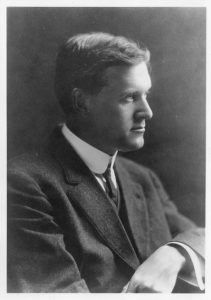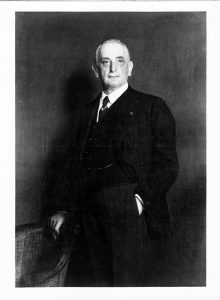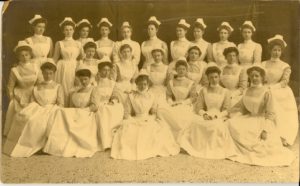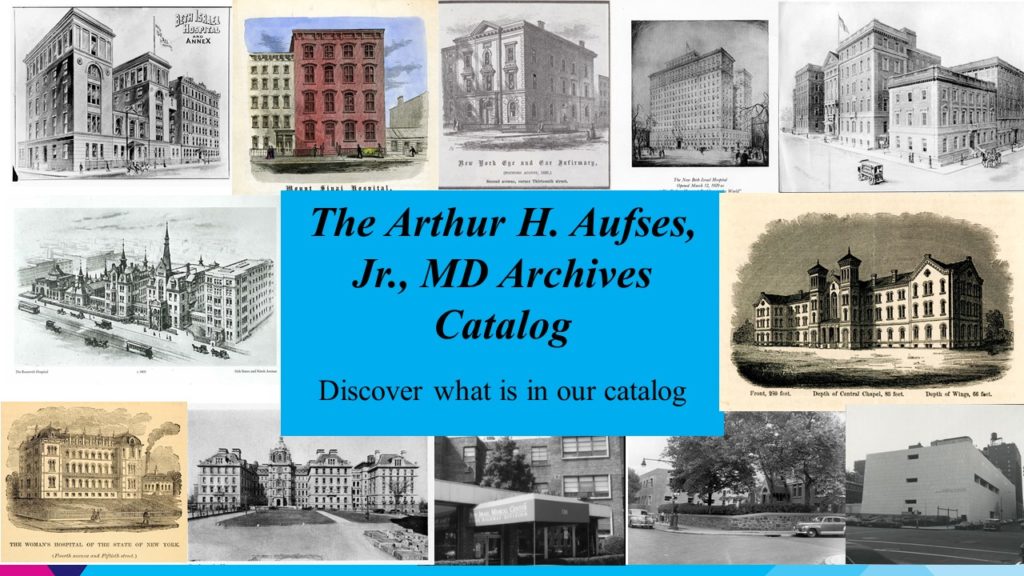Jul 7, 2021
Among the several anniversaries the Mount Sinai Health System will celebrate this year, is the centenary of the establishment of the Radiotherapeutic Department at our Morningside campus. The Department was established under the direction of Dr. Francis Carter Wood, who was the Hospital’s Pathologist, and the director of that Department beginning in 1910 when it separated from the Medical Service, until 1948.

Wood was born in 1869 in Columbus, Ohio, into a medical family – his grandfather was Dr. Francis Carter of Columbus, and his great-grandfather, Dr. Francis Boake Carter, was the founder of Starling Medical College in Columbus, now a part of the Ohio State University. Grandson Francis Carter Wood graduated from Ohio State University in 1891. He enrolled in the College of Physicians and Surgeons in New York, and graduated in 1894. Between 1894 and 1896, when he joined the faculty of clinical pathology at Columbia University, he continued his studies in Vienna and Berlin. He was a friend of Mme. Currie’s, whom he probably met during this time, and became interested in radium therapy.
He returned home to join the staff of St. Luke’s Hospital in 1897, eventually becoming the Hospital Pathologist. Wood’s interest in radium therapy led him to become a pioneer in the use of X-rays and radium therapy for the treatment of cancer. In 1905 the X-ray department, which until that time had been under the Pathology Department, formalized as its own service, under Wood’s direction.
Dr. Wood established the Radiotherapeutic Department in 1921, while remaining director of Pathology. The department started with six Associates training under Wood’s leadership. Within 5 years, the department was handling over 1,000 patients a year. Wood served as director of both departments until his retirement in 1948.
Upon his death in 1951 at the age of 81, Donald S. Childs, M.D wrote of Wood, “His greatest contributions were educating the public to a proper attitude toward cancer, disproving sensational but false “cures” for the disease, and developing the three most effective methods of treating cancer – surgery, x-rays, and radium.”
Jun 21, 2021
I recently spent some time reviewing the President’s Report section of the Annual Report of The Mount Sinai Hospital from 1921 (linked here, starting on page 190). The President then was George Blumenthal, a devoted trustee, and a smart businessman who had recently guided the Hospital through a major expansion program, the uncertainties of World War I, and the influenza epidemic of 1918. Reading the report reminded me of the joys – and problems – with reading primary historical sources: it is very easy in hindsight to see connections between two times that may not be related, and simple observations can seem very prescient.
Don’t get me wrong, parts of the report are very dated and irrelevant to today: the Hospital was unable to afford radium to use in patient treatment, and so that service was not provided. There was also a section on issues related to fund raising through the Federation of Jewish Charities (today’s UJA-Federation). But still, there were many issues that would seem familiar to our current leaders. The Hospital was perennially short of money, but after the epidemic and the war, wages were rising quickly for what today would be called “essential workers”. Adding to this was a restrictive immigration policy that limited the labor pool. The inability to hire as many trained nurses as they needed was a continuing struggle as well, something the whole country recognizes today.

George Blumenthal, President of The Mount Sinai Hospital from 1911-1938
And yet Blumenthal made the case – as we do today – for why private hospitals like Mount Sinai deserve the philanthropic support of the people. He says:
It is absolutely essential that private institutions like Mount Sinai should be leaders of progress in hospital work…. To discover, test and demonstrate new methods of treatment is recognized as one of the functions of private institutions and it is one of the strongest reasons for their existence and constitutes their most important claim on the generosity of the public which supports them.
A couple of pages later, Blumenthal makes a bold statement about the importance of Mount Sinai being a teaching hospital. At this time it had loose clinical ties to both Columbia and NYU. He envisioned something more:
A Hospital possessing the clinical and laboratory resources of Mount Sinai should have university affiliation or if this be impracticable should independently utilize its organization for teaching purposes, for in no other way can the fullest benefits be derived from the intensive study of interesting, varied and often perplexing clinical material. We hope the day is not very far off when work on these lines can be done either through affiliation with one of the many teaching institutions located in our city or by independent action.
And “independent action” it was. Even with academic affiliations with various medical schools, in the 1950s Mount Sinai was not satisfied that they were living up to their potential in terms of training the next generation of physician/scientists or using their immense clinical material for creating new medical knowledge to advance patient care. In 1963, the Trustees received a charter to create their own medical and graduate schools. The Mount Sinai School of Medicine opened in 1968.
Jun 9, 2021
Nurses’ Week has come and gone, but it is always worthwhile to celebrate our healthcare warriors and shine a light on their accomplishments. This post would like to highlight Elise Galloway, a 1906 graduate of the Roosevelt Hospital School of Nursing who went on to be a Roosevelt nurse for her whole career.

Elise Galloway
Galloway was born in Garrison, New York in 1878. The farmhouse she and her family lived in until the 1920s still stands on the property of the Garrison Grist Mill Historic District site. As a student, she would have worked one of two shifts – 7a.m. to 7p.m. or the reverse – 7p.m. to 7a.m. Nursing students generally had one half day off a week, two hourly breaks a day and time on Sundays for church. The bulk of their training would be on their assigned ward. Their responsibilities included daily grooming and washing of patients’ faces, hands and feet, weekly sponge bathing, taking temperatures and noting that and any other particular changes in the patients’ condition, changing dressings, and serving patients their meals and preparing additional special dishes, if a patient needed supplemental nourishment. Nurses would join the Attending Physician on rounds, noting instructions and assisting as needed. Student nurses would also have weekly lectures in anatomy, physiology, Materia Medica, gynecology, the digestive system, the practice of medicine, the ethics of private nursing, and surgical diseases and emergencies.

RHSON Class of 1906 – I believe she is sitting below Miss Samuels who is in the back row, fifth woman in from the left.
Galloway graduated with the class of 1906, and began working at Roosevelt right out of school. Miss Mary Alexander Samuels, was the exacting Directress of Nursing in charge of both the nursing staff and the nursing school. Miss Samuels, considered a keen observer, recognized Galloway’s fine nursing skills, and heard about her reputation for reliability and an ability to catch on quickly – a necessary skill for a job that was learned by doing. She assigned Galloway as nurse supervisor over the Syms Operating Theatre.
The Syms Theatre, opened in 1892, was one of the most advanced operating theaters in the country and had very high standards. Medical students from the College of Physicians and Surgeons, located across the street from the Hospital, trained there, and visiting surgeons frequently came to observe surgical procedures in its sky-lighted amphitheater. As Nurse Supervisor, Galloway had to make sure all her student nurses knew how to properly sterilize instruments, suture materials, towels, and sheets for surgery, something that was a long and complex process at that time, as well as how to work with the surgeons during a procedure. Galloway, noted as being a patient and kind teacher, earned the nickname, “Mother Galloway,” used by students and doctors alike.
Her Hospital service was interrupted only twice in her career – the first time was in 1915, for six months, while Galloway volunteered to work in France with the American Ambulance Corps, prior to the formal U.S. entry into World War I. When the U.S. joined the conflict, Galloway served as a member of Base Hospital 15, which was composed of doctors, nurses, and support staff all drawn from Roosevelt Hospital’s personnel. She served as the Nursing Supervisor, organizing the operating room staff much as she did in the Syms Theatre.

Officers and Nurses of Base Hospital 15. Elise Galloway is on the left, standing next to the Unit Head wearing the Mountie-type hat.
The unit remained in Chaumont, France for most of the war. However, Galloway, along with another nurse and, two doctors spent about ten weeks at a French evacuation hospital at the French front near Vasney, where she experienced air raids at close range in exchange for valuable experience in wound treatment techniques.
Returning home to the Syms Theatre and New York, doctors knew her as an invaluable assistant and friend; nurses knew her as an excellent teacher. She was said to have an unfailing good temper, always calm, retaining poise in any emergency, and very unselfish, presenting the profession of nursing nobly and exemplifying the spirit of service and high standards that nursing is strives for.
The alumni newsletter notes that Elise Galloway left Roosevelt Hospital after an operation in the summer of 1933, and died in the Hospital on September 20, 1934 after an illness of several months.
Jun 1, 2021
We are pleased to announce that the new Archives Catalog is live. Access it here to search or browse our collection.

You can read more about it in our previous post or consult the FAQ page for more information. Happy researching!
May 10, 2021
The Aufses Archives is excited to announce its new online catalog. Based in AtoM, the catalog will make available records for all our archival material and provide direct access to our digital objects.

What does this mean for researchers?
Our new catalog has several new features:
- A more complete view of our holdings: This is the first time all of our material will be described together in one place, regardless of format and digitization status. All our publicly available material will have a record, whether or not it has been fully processed or has a complete finding aid. (An archival record is like a record for a book in a library catalog – you might not be able to download the whole book from the catalog, but you can see that they have it and how to access it.)
- Centralized digital resources: All our digital material will be in one place, regardless of its original format. Researchers will only have to search in one place for our digital material. This includes our web archives collection.
- Names, subjects, genres: Looking for something really specific? Search results can be filtered and faceted to include specific people, topics, and formats represented in the archival material.
- Improved searching: Material will be findable via keyword searching, within and across collections. Advanced search will be particularly helpful for those searching for material within a particular date range.

When can I use it?
The catalog will go live on June 1, 2021, with the majority of our archival records. Our digitized audiovisual and image collections will be added over the course of Summer 2021. Our born-digital and digitized records then will be incorporated starting in Fall 2021, with a project completion date in early 2022.
I need help using the new catalog — and I have feedback!
Contact us! We’re happy to help you find what you’re looking for.
Update: As of June 1, 2021, the Archives Catalog is live and available here.








